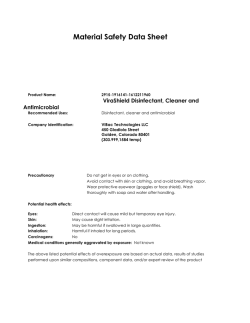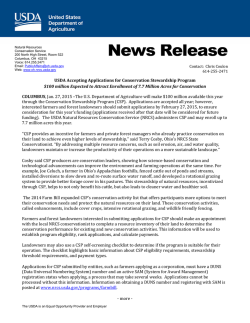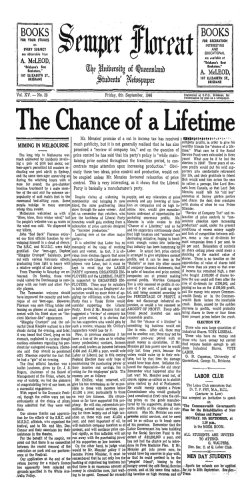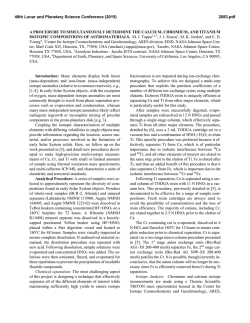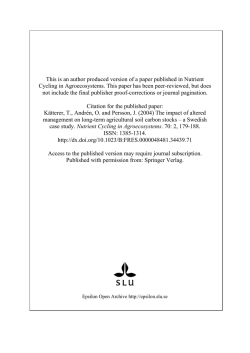
Effect of Cu toxicity on growth of Cowpea (Vigna unguiculata)
Kopittke, P.M., and N.W. Menzies. 2006. Plant Soil 279:287-296. Effect of Cu toxicity on growth of Cowpea (Vigna unguiculata) Peter M. Kopittke1, Neal W. Menzies School of Land and Food Sciences, The University of Queensland, St. Lucia, Qld, Australia, 4072. Ph: +61 7 3365 2079, Fax: +61 7 3365 1177, Email: [email protected] 1 Corresponding author Abstract Accurate determination of the rhizotoxicity of Cu in dilute nutrient solutions is hindered by the difficulty of maintaining constant, pre-determined concentrations of Cu (micromolar) in solution. The critical Cu2+ activity associated with a reduction in the growth of solution-grown cowpea (Vigna unguiculata (L.) Walp. cv Caloona) was determined in a system in which Cu was maintained constant through the use of a cation exchange resin. The growth of roots and shoots was found to be reduced at solution Cu2+ activities ≥ 1.7 µM (corresponding to 90 % maximum growth). Although root growth was most likely reduced due to a direct Cu2+ toxicity, it is considered that the shoot growth reduction is attributable to a decrease in tissue concentrations of K, Ca, Mg, and Fe and the formation of interveinal chlorosis. At high Cu2+ activities, roots were brown in color, short and thick, had bent root tips with cracking of the epidermis and outer cortex, and had local swellings behind the roots tips due to a reduction in cell elongation. Root hair growth was reduced at concentrations lower than that which caused a significant reduction in overall root fresh weight. Abbreviations: CDTA – cyclohexane-1,2-diaminetetra-acetic acid; DI – deionised; EC – electrical conductivity; I – ionic strength; ICPAES – inductively coupled plasma atomic emission spectrometry; ICPMS – inductively coupled plasma mass spectrometry - Page 1 – Kopittke, P.M., and N.W. Menzies. 2006. Plant Soil 279:287-296. Introduction Copper is an essential plant micronutrient, required for the protein components of several enzymes (Marschner 1995). However, when present in excess quantities, Cu is also highly toxic to plant growth potentially causing damage resulting in complete inhibition of growth. This accumulation of toxic Cu concentrations has been observed on both naturally ‘polluted’ soils (for example, Cu ore outcrops) (Eleftheriou and Karataglis 1989) and on anthropogenically polluted soils (such as from mining, smelting, waste disposal, and the use of fertilizers and fungicides). Although the toxicity of Cu has been the subject of much research, few studies report measuring solution Cu concentrations during the experimental period, but rather relate plant growth to the amount of Cu initially added. This may potentially lead to erroneous results, particularly in longerterm experiments where plant uptake, adsorption onto the root apoplasm, and precipitation from solution result in a reduction in the Cu concentration. Studying the toxicity of Cu to native Australian tree species over a 70 d growth period, Reichman (2001) reported that even with regular replacement additions to maintain solution Cu, concentrations varied by up to 90 % (Reichman 2001). Ion exchange resins have been used in solution culture experiments for nearly 60 years (Arnon and Grossenbacker 1947), and have been used to buffer solution concentrations of several ions including H+ (pH), Ca, Mg, K, Mn, Zn, and Ni with varying success (Checkai et al. 1987; Checkai and Norvell 1992; Hageman et al. 1961; Harper and Nicholas 1976). Resins offer the advantage of being able to buffer nutrient concentrations at low levels without the need for organic chelates. In general, however, the use of ion exchange resins has not been widespread, particularly in regards to heavy metal toxicity. The use of ion exchange resins to buffer defined concentrations of heavy metals requires accurate pH control due to the variable charge nature of the resins. Although using - Page 2 – Kopittke, P.M., and N.W. Menzies. 2006. Plant Soil 279:287-296. resins to buffer Cu, Sheldon and Menzies (2005) found solution Cu concentrations to vary by up to 250 % due to changes in solution pH. The objective of the current work was to quantify the critical free Cu2+ activity associated with a reduction in growth of solution-grown cowpea. Automatic titration units were used to control pH, and solution Cu concentrations were maintained constant through the use of ion exchange resins. Growth of both the roots and shoots were related to Cu2+ activities as calculated from measured Cu concentrations. Optical microscopy was used to examine the effect of high solution Cu on root morphology. Materials and Methods Resin preparation Approximately 400 g of Amberlite IRC-748 (Aldrich) ion exchange resin was placed into a column and leached with methanol until the effluent was clear. Five volumes of deionised (DI) water were then passed through the resin. Using 20 volumes of approximately 1.0 M HCl, the resin was converted from the Na-form to the H-form, and was then leached with 20 volumes of DI water. The resin was placed in two 5 L beakers, with Cu- and Ca-forms prepared by the addition of 2 L of the appropriate chloride salt solution (2 mM CuCl2 or CaCl2) to the beaker. The pH of the solution was then raised to pH 4.50 (± 0.03) using 0.1 M KOH for the Cu-form, and saturated Ca(OH)2 (approximately 0.02 M) for the Ca-form. The equilibrating chloride salt solution was replaced daily (and further pH titrant added) until the replacement equilibration solution (without pH titrant added) was pH 4.50 (± 0.03). The Cu saturated resin was then washed with 2 mM CuCl2 to remove/desorb any K in the entrained solution or on the resin exchange as a result of KOH addition. A Buchner funnel was used to remove excess moisture from the resin forms, and the moisture content determined after oven drying a sub-sample. The Cu and Ca resins were mixed at eight ratios - Page 3 – Kopittke, P.M., and N.W. Menzies. 2006. Plant Soil 279:287-296. (1.3, 4.0, 5.0, 20, 45, 65, 75, and 85 % Cu-form resin) so as to yield a total resin mass of 10.5 g (0.5 g resin L-1 of the final nutrient solution). Following mixing, 20 mL of 2 mM CaCl2 added to each resin mixture and the resins allowed to equilibrate for 14 d. By this time, exchange of Cu and Ca between resins had resulted in the resin beads having a uniform color (Cu-saturated resin is blue, Ca-saturated resin is white). Due to the high affinity of the resin for both Mn and Zn (manufacturer’s guidelines), any Mn and Zn supplied to a nutrient solution for plant growth would be rapidly taken out of solution and onto the Cu/Ca resin mixture. Indeed, preliminary experiments indicated that unless Zn and Mn were added as resins the plants would develop Zn and Mn deficiency. Therefore, in order to maintain sufficient concentrations of these micronutrients in solution, Mn- and Zn-saturated resins were prepared (as described above). Solution culture Experiments were carried out in controlled glasshouse conditions, with high pressure sodium lamps supplementing natural sunlight, providing 16 h of light per day. Temperature was maintained at 30 C during the light period and 25 C during the dark. Twenty four polypropylene containers (22 L; 265 mm diameter by 400 mm deep) were arranged in a completely randomized design with a total of eight treatments (1.3, 4.0, 5.0 20, 45, 65, 75, and 85 % Cu-form resin) and three replicates. An air-driven water pump was placed in each container, and the resin in a PVC container with 150 µm mesh ends (see diagram in Sheldon and Menzies (2005)). The pump was used to force the solution through the resin, and also to aerate the solution. After an initial 24 h aeration, each container was connected to a separate pH titration unit (TPS, miniCHEMpH) and peristaltic pump (Masterflex 5 RPM with Masterflex Tygon tubing, L/S 17) which was used to raise and maintain the pH at 4.5 by the addition of 0.025 M Ca(OH)2. The resin mixtures - Page 4 – Kopittke, P.M., and N.W. Menzies. 2006. Plant Soil 279:287-296. were added to each pot, 0.5 g of each of the Mn and Zn resins incorporated, and the solutions allowed to equilibrate for 14 d. After equilibration, the nutrient solution was found to contain approximately 0.6 µM Zn and 0.8 µM Mn. Cowpea seeds (Vigna unguiculata (L.) Walp. cv Caloona) were imbibed in aerated 200 μM CaSO4 solution for 2 h. Seeds were rolled in paper towel, and germinated for 36 h at 30 ºC with the ends of the paper towel immersed in tap water. Four seedlings with radicle lengths of 10 ± 2 mm were transferred to each container. Nutrients were supplied through the use of a dilute basal nutrient solution (added upon initiation of the experiment), and the incremental addition of a delivery nutrient solution at quantities calculated to meet plant demand. Each container was filled with a basal nutrient solution, with the Cu supplied from the ion exchange resins. GEOCHEM v2.0 (Parker et al. 1995) was used to check the complexation of Cu by various chelates used to maintain Fe in solution. Across the Cu concentrations of interest (and at pH 4.50) CDTA (cyclohexane-1,2-diaminetetra-acetic acid) complexed the least Cu out of those chelates examined; approximately 0.35-1.3 % of the total solution Cu. In contrast, EDDHA complexed 1.3-4.0 % of the total solution Cu, EDTA complexed 2.8-7.8 %, NTA (nitrilotriacetate) complexed 65-91 %, and HEDTA (hydroxyethylethylenediaminetriacetic acid) complexed 75-95 %. Therefore, to minimize Cu complexation, Fe was supplied as FeCDTA (Table 1). To prepare the 10 mM FeCDTA stock solution, 3.64 g of CDTA (Sigma) was placed in a 1 L volumetric flask and approximately 500 mL of DI water added, with 7.2 mL of 5 M NaOH used to raise pH. 4.04 g Fe(NO 3)3.9H2O was dissolved in 300 mL DI water, and the solution slowly added to the CDTA, with the final solution volume raised to 1 L. Although each container was connected to a pH titration unit, the NO3-/NH4+ ratio (85:15) was predetermined so as to minimize pH variance. - Page 5 – Kopittke, P.M., and N.W. Menzies. 2006. Plant Soil 279:287-296. In addition to this basal nutrient solution, nutrients were supplied to the plants through the addition of a calculated quantity of delivery nutrient solution (Table 1). Plant growth was calculated from the exponential equation: W t = W0 e (RGR×t ) where Wt is the plant dry mass (g) at time t (d), W 0 is plant mass at t = 0, and RGR is the relative growth rate (g g-1 d-1) (Stadt et al. 1992). Using a RGR of 0.20 g g-1 d-1, the daily nutrient additions (At) required in a given time interval were calculated for N (assuming a plant N concentration (C) of 0.05 g N (g dry mass)-1), with the other nutrients added in the delivery solution in proportion to N (Table 1): A t = C × W0 e (RGR×t ) × (e RGR - 1) where W0 is plant mass at t = 0 (calculated to be 0.15 g pot-1) (Taylor et al. 1998). The delivery nutrient solution was added at the calculated rate three times during the first 7 d, then daily afterwards. Additional DI water was supplied to the containers throughout the growth period to maintain solution volume. Plants were allowed to grow for a total of 14 d from their introduction to the nutrient solution until termination of the experiment. Electrical conductivity (EC) was measured twice weekly, with the pH electrode in each container also calibrated. Nutrient solution samples were taken on days 0, 7, and 14, filtered (0.22 µm Millipore GSWP), acidified to pH < 2.0 using 20 µL of concentrated HCl, and refrigerated (3.5 ºC) before analysis by inductively coupled plasma atomic emission spectrometry (ICPAES) and inductively coupled plasma mass spectrometry (ICPMS). Upon completion of the experiment, selected roots were taken from each treatment, stained using 0.5 % crystal violet, and examined - Page 6 – Kopittke, P.M., and N.W. Menzies. 2006. Plant Soil 279:287-296. using light microscopy. The fresh mass of the remaining roots and shoots was determined, the roots thoroughly rinsed in DI water (5 mins), and the elemental concentrations of both the roots and shoots determined using ICPAES after drying for 7 d at 65 ºC and acid digestion as described by Martinie and Schilt (1976). For relative shoot and root mass, a grouped regression analysis (fitting logistic curves) was performed using GenStat 7 (GenStat 2003). Regression analysis was also used to examine the relationship between nutrient solution Cu2+ activity (calculated from the measured Cu concentration) and the root (linear regression model) and shoot (Mitscherlich (exponential) regression model) Cu concentrations as determined upon completion of the trial (GenStat 2003). All calculations of ionic strength (I) and ion activities were performed using PhreeqcI 2.11 with the Minteq database (Parkhurst 2005). Chelated Cu accounted for < 1.3 % of the total solution Cu, with Cu2+ accounting for > 99.9 % of the remaining soluble Cu forms. Results Root and shoot growth was found to decrease with increasing solution Cu2+ activity (p < 0.001) (Figure 1). In addition, the pattern of response to increasing solution Cu2+ activity was the same for both the shoots and the roots, with separate parameters not required to describe individual root and shoot curves (p = 0.599) (Figure 1). Thus, the critical Cu2+ activity (corresponding to 90 % maximum yield) of 1.7 µM was the same for both the roots and shoots (Figure 1). Solution concentrations of Cu (buffered by the cation exchange resin) remained relatively constant throughout the 14 d experimental period, with measured values varying by no more than 15 % within each treatment (data not presented). Concentrations of most nutrients remained relatively constant over time, although the average Zn concentration of 0.48 µM (supplied by the Zn-form resin) was lower than expected. It was noted that solution Ca concentrations tended to increase over - Page 7 – Kopittke, P.M., and N.W. Menzies. 2006. Plant Soil 279:287-296. time due to the addition of Ca(OH)2 for pH regulation (Figure 2). This was particularly true in the low Cu solutions where growth (and hence pH change) was greatest. It was also noted that the concentrations of a few elements (such as K) tended to decrease slightly - particularly in the low Cu solutions in which growth was more rapid (Figure 2). As a result of this nutrient uptake and depletion, solution EC decreased slightly over the experimental period (Figure 2). Although it was expected that this EC decrease would be greater in the low Cu treatments (due to more rapid growth), similar trends were observed in all solutions (Figure 2). It is considered that the more rapid uptake of nutrients in the low Cu solutions was offset by this higher rate of Ca(OH)2 addition for pH regulation (Figure 2). Due to the optimization of the NO3-/NH4+ ratio, the quantity of titrant added for maintenance of pH was comparatively small, with measurements showing that in a pot in which no titrant was added, pH reduced from 4.5 to approximately 4.2 (data not presented). Although nutrient supply was generally good, approximately 3 days after planting (DAP) interveinal chlorosis was observed in the shoots of plants in the two highest Cu treatments. In addition, during the last 2 d of growth symptoms of Mn toxicity (brown necrotic spots on the leaves (Iwasaki et al. 2002)) were observed in the low Cu solutions. This observation of Mn toxicity was confirmed with the analysis of the shoot tissue also indicating that Mn was toxic in these treatments (Table 2). Shoot and root concentrations of K, Ca, Mg, Fe and Mn tended to decrease with increasing Cu, whilst S, P and B concentrations remained steady or increased slightly (Table 2). It was also noted that shoot concentrations of Zn and Fe in the low Cu solutions were higher than expected (Table 2). Concentrations of Cu in both the root and shoot increased with increasing solution Cu activity, although concentrations were approximately 10-fold greater in the roots than in the shoots (Table 2 and Figure 3). The increase in shoot Cu with increasing solution concentrations was almost linear, whilst root Cu increased exponentially with increasing solution Cu (Figure 3). - Page 8 – Kopittke, P.M., and N.W. Menzies. 2006. Plant Soil 279:287-296. Other than the obvious stunting (Figure 4a), examination of the root system revealed the formation of toxicity symptoms in the three highest Cu treatments (1.9, 2.4 and 2.7 µM Cu2+) with the severity of the symptoms increasing with increasing Cu2+. Roots from these high Cu treatments tended to have slightly bent root tips, particularly at 2.7 µM Cu2+ where severe lesions due to the cracking of the epidermis and outer cortex were also evident (Figure 4b). In addition, examination of roots at 2.7 µM Cu2+ revealed the formation of local swellings immediately behind the tip of many of the lateral roots (Figure 4c and Figure 4d). The cells in these swellings tended to be circular in shape rather than elongated as in the remainder of the root. It was also noted that root hair formation tended to be inhibited in solutions with a Cu2+ activity ≥ 0.89 µM. Discussion Root and shoot growth of cowpea was reduced in dilute nutrient solutions (I = 3.2 mM) containing a Cu2+ activity ≥ 1.7 µM (corresponding to 90 % maximum growth) (Figure 1). Although cation exchange resins have previously been used to buffer Cu concentrations (Sheldon and Menzies 2005), inadequate pH control in this previous study resulted in large fluctuations in solution Cu concentrations (Cu up to 250 % greater than the desired concentration in some treatments) due to changes in the resins variable charge cation exchange capacity. The use of the pH stat system in the current study not only ensured constant pH, but also relatively constant solution Cu concentrations. However, in all previous studies other than Sheldon and Menzies (2005), solution Cu concentrations were not buffered but typically added as an inorganic salt such as CuSO4.5H2O. Further, in many studies solution Cu concentrations were not even measured (either during, or upon completion of the experiment), but the concentration simply assumed to be that at which it was added. Failure to account for Cu uptake from solution and its adsorption onto the root apoplasm may result in the overestimation of the solution concentration, and hence underestimation of Cu toxicity. Although solution Cu concentrations were not measured, most of these previous studies utilised periodic renewal of the nutrient solutions to attempt to maintain constant Cu levels. The - Page 9 – Kopittke, P.M., and N.W. Menzies. 2006. Plant Soil 279:287-296. time between renewal, however, varied - ranging from 2 d (Liao et al. 2000), 7 d (Zhu and Alva 1993), to 21 d (Hill et al. 2000), or not at all (Taylor and Foy 1985). Further, the efficiency of renewal on maintaining the desired Cu concentrations was not measured in any of these aforementioned studies. Studying several native Australian tree species, Reichman (2001) found that even with the addition of Cu every 7 d, solution Cu concentrations varied by up to 90 %, particularly in the low Cu treatments. It is therefore possible that many of the previously reported Cu tolerances are indeed overestimations of the true value, particularly in longer-term experiments where Cu removal by plants would be the greatest. Relative fresh weights of both the roots and shoots decreased in similar pattern as solution Cu increased, with separate parameters not required to describe individual root and shoot curves (p = 0.599) (Figure 1). Similar results have been reported by Zhu and Alva (1993), Lin et al. (2003) and Ali et al. (2002), who also found shoot growth to decrease significantly at the same Cu concentration that caused a significant decrease in root growth. However, whilst shoot Cu concentrations increased with increasing solution Cu, tissue concentrations of Cu were approximately 10-fold greater in the roots than the shoots (Table 2 and Figure 3). Further, it was noted that the decrease in root and shoot mass in solutions with a Cu2+ activity ≥ 1.7 µM (Figure 1) corresponded with a steep increase in root Cu concentrations (Figure 3). Therefore, it is considered that this shoot growth reduction is not due to a direct toxicity of Cu in the shoots, but rather to nutrient deficiencies resulting from a reduced nutrient uptake by the damaged roots (Zhu and Alva 1993). Although the nutrient solutions contained sufficient nutrients, when compared to the control, plants growing in high Cu solutions were found to have reduced shoot concentrations of K, Ca, Mg, Fe and Mn, with concentrations often below the approximate critical concentration for deficiency (Table 2). Indeed, interveinal chlorosis (consistent with Fe deficiency) was observed in the two highest Cu treatments approximately 3 DAP. Decreases in shoot concentrations of Ca, Mg and Fe and is typical of Cu toxicity (Ali et al. 2002; Lidon and Henriques 1993; Ouzounidou et al. 1995; - Page 10 – Kopittke, P.M., and N.W. Menzies. 2006. Plant Soil 279:287-296. Panou-Filotheou and Bosabalidis 2004) and is most likely due to a nonspecific effect of Cu on ion absorption and translocation due to an impairment of root function (for example, membrane leakiness, reduced ion uptake, or a reduction in radial transport or xylem loading). Induced Fe deficiency has often been reported to be associated with Cu toxicity (Ouzounidou 1994; Taylor and Foy 1985), and is also typical of toxicities of other metals such as Al, Co, Tl and Ni (Clark et al. 1981; Kaplan et al. 1990). It was also noted that shoot tissue concentrations of Zn and Fe in the low Cu solutions tended to be higher than expected, although not thought to be toxic (Table 2). For future studies, the use of preliminary investigations to optimize of solution nutrient concentrations would be beneficial. The approximate plant tissue Cu concentrations corresponding to 90 % maximum yield (20 µg/g shoot, and 66 µg/g root (Figure 3)) were found to be similar to the critical concentrations of 67 µg/g leaves and 41 µg/g root reported by Kalyanaraman and Sivagurunathan (1993) for the closely related species Vigna mungo. In contrast, concentrations reported for other species differ substantially; 26 µg/g shoot and 290 µg/g root in Chloris gayana (Sheldon and Menzies 2005), 340 µg/g root for Zea mays (Ouzounidou et al. 1995), 21 µg/g shoot and 170 µg/g root for Zea mays and 55 µg/g shoot and 3100 µg/g root for Phragmites australis (Ali et al. 2002), and 15 µg/g shoot and 2300 µg/g root for Triticum aestivum (Taylor and Foy 1985). This variation in critical contents is not unexpected however, as it is considered that there is only a poor relationship between the critical root tissue Cu concentration and growth. Examining excised root tips (the region in which Cu would be most likely adversely effect root growth), Parker et al. (1998) reported that growth inhibition was only weakly correlated with symplastic, apoplastic, and total Cu contents. In addition to the shoot symptoms observed (growth reduction and interveinal chlorosis), roots grown in the three highest Cu treatments (1.9, 2.4 and 2.7 µM Cu2+) also displayed typical Cu toxicity symptoms with the severity of the symptoms increasing with increasing Cu2+. Roots from - Page 11 – Kopittke, P.M., and N.W. Menzies. 2006. Plant Soil 279:287-296. all three of the highest treatments tended to have slightly bent root tips, particularly at 2.7 µM Cu2+ where roots also displayed a deterioration and cracking of the epidermis (Panou-Filotheou and Bosabalidis 2004) (Figure 4). It has been proposed that the epidermal cracking observed under metal toxicity is due to the differences in elongation rate between the inner and outer cells (Wagatsuma et al. 1987). It was also noted that roots grown at 2.7 µM Cu2+ tended to be brown in color, short, thick, and highly branched (‘barb-wire roots’) (Kabata-Pendias and Pendias 2001; Zhu and Alva 1993). Roots at the highest Cu also often displayed localized swellings behind the tips of many of the lateral roots which were noted to contain plate-like cells rather than the typical elongated cells (Figure 4). This formation of plate-like cells is attributed to a restriction in cell elongation associated with Cu toxicity (Panou-Filotheou and Bosabalidis 2004; Savage et al. 1981). Although the symptoms described above were observed in solutions containing ≥ 1.9 µM Cu2+, it was noted that root hairs were more sensitive, with reductions in root hair formation occurring at ≥ 0.89 µM Cu2+. These root symptoms observed for Cu toxicity are similar to those described by others for Al toxicity (Blamey et al. 2004; Kopittke et al. 2004; Yamamoto et al. 2001). Also, as seen for Al toxicity, it would be expected that the Cu-induced reduction of root hair formation would result in inhibition of nodulation by N2 fixing bacteria in leguminous species (Brady et al. 1993). Although Mn toxicity was observed in the lower Cu treatments 2 d before completion of the experiment, this is not considered to have substantially affected the results; the growth reduction in these treatments would in fact reduce any differences between the low and high Cu treatments. Further, Mn toxicity has been reported not to affect root hair growth (Wood et al. 1984), as was evidenced in the current study by the good root hair growth observed in the low Cu solutions. This Mn toxicity is due to the displacement of Mn from the resin by other cations with greater affinities for the resin’s binding sites (such as Cu2+, Ca2+, and Zn2+) (manufacturer’s guidelines). Cowpea has - Page 12 – Kopittke, P.M., and N.W. Menzies. 2006. Plant Soil 279:287-296. previously been reported to be particularly sensitive to Mn, with toxicities often developing at solution concentrations considered adequate for other species (Smith et al. 1983). Tissue analysis confirmed the presence of Mn toxicity, with the shoot Mn concentrations (approximately 300 µM in the low Cu solutions (Table 2)) greater than the 200-250 µg/g previously reported to be toxic (Ashwath 1990; Wissemeier and Horst 1990). The Mn toxicity (and associated growth reduction) was observed only in the low Cu treatments; growth in the higher Cu treatments was inhibited more by Cu toxicity than Mn toxicity. Conclusions Unlike most previous studies, solution Cu was buffered (using a cation exchange resin) and its concentrations measured throughout the duration of the experiment. The growth of roots and shoots was found to be reduced at solution Cu2+ activities ≥ 1.7 µM (corresponding to 90 % maximum growth). This observed decrease in shoot growth is not considered to be the result of a direct Cu toxicity to the shoots, but rather a reduction in growth due to nutrient deficiencies caused by damage to the roots; concentrations of K, Ca, Mg, and Fe decreased as solution Cu increased. At high Cu2+ activities, roots were brown in color, short and thick, with bent root tips and cracking of the epidermis and outer cortex. Local swellings, due to a reduction in cell elongation, were present behind many of the root tips. Root hair growth was reduced at activities lower than that which caused a significant reduction in root growth. Acknowledgments The authors recognize the comments, suggestions and ideas of Anna Sheldon and Michael Donn. Michael Geyer is also gratefully acknowledged for his assistance with the sample preparation and analysis. - Page 13 – Kopittke, P.M., and N.W. Menzies. 2006. Plant Soil 279:287-296. References Ali N A, Bernal M P and Ater M 2002 Tolerance and bioaccumulation of copper in Phragmites australis and Zea mays. Plant Soil 239, 103-111. Arnon D I and Grossenbacker K A 1947 Nutrient culture of crops with the use of synthetic ion exchange materials. Soil Sci. 63, 159-181. Ashwath D C 1990 Effects of manganese toxicity on growth and nodulation of tropical grain legumes. M.Sc. Thesis, School of Agronomy and Horticulture, The University of Queensland. 172 p. Blamey F P C, Nishizawa N K and Yoshimura E 2004 Timing, magnitude, and location of initial soluble aluminium injuries to mungbean roots. Soil Sci. Plant Nutr. 50, 67-76. Brady D J, Edwards D G, Asher C J and Blamey F P C 1993 Calcium amelioration of aluminium toxicity effects on root hair development in soybean (Glycine max (L.) Merr.). New Phytol. 123, 531-538. Checkai R T, Hendrickson L L, Corey R B and Helmke P A 1987 A method for controlling the activities of free metal, hydrogen, and phosphate ions in hydroponic solutions using ion exchange and chelating resins. Plant Soil 99, 321-334. Checkai R T and Norvell W A 1992 A recirculating resin-buffered hydroponic system for controlling nutrient ion activities. J. Plant Nutr. 15, 871-892. Clark R B, Pier P A, Knudsen D and Maranville J W 1981 Effect of trace element deficiencies and excesses on mineral nutrients in sorghum. J. Plant Nutr. 3, 357-374. Eleftheriou E P and Karataglis S 1989 Ultrastructural and morphological characteristics of cultivated wheat growing on copper-polluted fields. Bot. Acta 102, 134-140. GenStat 2003 GenStat for Windows. Release 7.2. Seventh Edition. VSN International Ltd., Oxford. Hageman R H, Flesher D, Wabol J J and Storck D H 1961 An improved nutrient culture technique for growing corn under greenhouse conditions. Agron. J. 53, 175-180. - Page 14 – Kopittke, P.M., and N.W. Menzies. 2006. Plant Soil 279:287-296. Harper J E and Nicholas J C 1976 Control of nutrient solution pH with an ion exchange system: effect on soybean nodulation. Physiol. Plant. 38, 24-28. Hill S A, Miyasaka S C and Yost R S 2000 Taro responses to excess copper in solution culture. Hortscience 35, 863-867. Iwasaki K, Maier P, Fecht M and Horst W J 2002 Effects of silicon supply on apoplastic manganese concentrations in leaves and their relation to manganese tolerance in cowpea (Vigna unguiculata (L.) Walp.). Plant Soil 238, 281-288. Kabata-Pendias A and Pendias H 2001 Trace Elements in Soils and Plants. CRC Press, Boca Raton, FL. 413 p. Kalyanaraman S B and Sivagurunathan P 1993 Effect of cadmium, copper, and zinc on the growth of blackgram. J. Plant Nutr. 16, 2029-2042. Kaplan D I, Adriano D C and Sajwan K S 1990 Thallium toxicity in bean. J. Environ. Qual. 19, 359-365. Kopittke P M, Menzies N W and Blamey F P C 2004 Rhizotoxicity of aluminate and polycationic aluminium at high pH. Plant Soil 266, 343-354. Liao M T, Hedley M J, Woolley D J, Brooks R R and Nichols M A 2000 Copper uptake and translocation in chicory (Cichorium intybus L. cv. Grasslands Puna) and tomato (Lycopersicon esculentum Mill. cv. Rondy) plants grown in NFT system. I. Copper uptake and distribution in plants. Plant Soil 221, 135-142. Lidon F C and Henriques F S 1993 Effects of copper toxicity on growth and the uptake and translocation of metals in rice plants. J. Plant Nutr. 16, 1449-1464. Lin J, Jiang W and Liu D 2003 Accumulation of copper by roots, hypocotyls, cotyledons and leaves of sunflower (Helianthus annuus L.). Bioresource Technol. 86, 151-155. Marschner H 1995 Mineral Nutrition of Higher Plants. Academic Press, London. 889 p. Martinie G D and Schilt A A 1976 Investigation of the wet oxidation efficiencies of perchloric acid mixtures. Anal. Chem. 48, 70-74. - Page 15 – Kopittke, P.M., and N.W. Menzies. 2006. Plant Soil 279:287-296. Ouzounidou G 1994 Root growth and pigment composition in relationship to element uptake in Silene compacta plants treated with copper. J. Plant Nutr. 17, 933-943. Ouzounidou G, Ciamporova M, Moustakas M and Karataglis S 1995 Responses of maize (Zea mays L.) plants to copper stress - I. Growth, mineral content and ultrastructure of roots. Environ. Exp. Bot. 35, 167-176. Panou-Filotheou H and Bosabalidis A M 2004 Root structural aspects associated with copper toxicity in oregano (Origanum vulgare subsp. hirtum). Plant Sci. 166, 1497-1504. Parker D R, Norvell W A and Chaney R L 1995 GEOCHEM-PC: A chemical speciation program for IBM and compatible personal computers. In Chemical equilibrium and reaction models, Eds R H Loeppert, A P Schwab and S Goldberg. pp 253-269. Soil Science Society of America and American Society of Agronomy, Madison, WI. Parker D R, Pedler J F, Thomason D N and Li H 1998 Alleviation of copper rhizotoxicity by calcium and magnesium at defined free metal-ion activities. Soil Sci. Soc. Am. J. 62, 965972. Parkhurst D 2005 PhreeqcI. United States Geological Survey. http://water.usgs.gov/owq/software.html (Accessed March 2005). Reichman S M 2001 Responses of Australian native plants to metal toxicity. Ph.D. Thesis, School of Land and Food Sciences, The University of Queensland. 252 p. Reuter D J and Edwards D G 1997 Temperate and tropical crops. In Plant Analysis : An Interpretation Manual, Eds D J Reuter and J B D Robinson. pp 83-284. CSIRO Publishing, Collingwood. Savage W, Berry W L and Reed C A 1981 Effects of trace element stress on the morphology of developing seedlings of lettuce (Lactuca sativa L. Grand Rapids) as shown by scanning electron microscopy. J. Plant Nutr. 3, 129-138. - Page 16 – Kopittke, P.M., and N.W. Menzies. 2006. Plant Soil 279:287-296. Sheldon A R and Menzies N W 2005 The effect of copper toxicity on the growth and root morphology of Rhodes grass (Chloris gayana Knuth.) in resin buffered solution culture. Plant Soil. In Press, PLSO1584R1. Smith F W, Imrie B C and Pieters W H J 1983 Foliar Symptoms of Nutrient Disorders in Mung Bean (Vigna radiata). Commonwealth Scientific and Industrial Research Organisation. 11 p. Smith G S, Cornforth I S and Henderson H V 1984 Iron requirements of C3 pathway and C4 pathway plants. New Phytol. 97, 543-556. Stadt K J, Taylor G J and Dale M R T 1992 Control of relative growth rate by application of the relative addition rate technique to a traditional solution culture system. Plant Soil 142, 113122. Taylor G J, Blamey F P C and Edwards D G 1998 Antagonistic and synergistic interactions between aluminum and manganese on growth of Vigna unguiculata at low ionic strength. Physiol. Plant. 104, 183-194. Taylor G J and Foy C D 1985 Differential uptake and toxicity of ionic and chelated copper in Triticum aestivum. Can. J. Bot. 63, 1271-1275. Wagatsuma T, Kaneko M and Hayasaka Y 1987 Destruction process of plant-root cells by aluminum. Soil Sci. Plant Nutr. 33, 161-175. Wissemeier A H and Horst W J 1990 Manganese oxidation capacity of homogenates of cowpea (Vigna unguiculata (L.) Walp) leaves differing in manganese tolerance. J. Plant Physiol. 136, 103-109. Wood M, Cooper J E and Holding A J 1984 Soil acidity factors and nodulation of Trifolium repens. Plant Soil 78, 367-397. Yamamoto Y, Kobayashi Y and Matsumoto H 2001 Lipid peroxidation is an early symptom triggered by aluminum, but not the primary cause of elongation inhibition in pea roots. Plant Physiol. 125, 199-208. - Page 17 – Kopittke, P.M., and N.W. Menzies. 2006. Plant Soil 279:287-296. Zhu B and Alva A K 1993 Effect of pH on growth and uptake of copper by Swingle citrumelo seedlings. J. Plant Nutr. 16, 1837-1845. - Page 18 – Kopittke, P.M., and N.W. Menzies. 2006. Plant Soil 279:287-296. Table 1. Composition of the basal nutrient solution supplied at the beginning of the experiment, and the delivery nutrient solution added throughout the duration of the experiment in quantities calculated to meet plant demand. Basal Delivery (µM) (mM) NO3-N 680 680 NH4+-N 120 120 K 302 400 Ca 650 150 Cl 140 234 Mg 50 75 S 502 20 P 2 20 Fe 10 5 B 3 1 Mo 0.02 0.02 Cu† 0 0 Mn† 0 0 Zn† 0 0 † These nutrients were supplied by the Cu-, Mn-, and Zn-forms of the cation exchange resin - Page 19 – Kopittke, P.M., and N.W. Menzies. 2006. Plant Soil 279:287-296. Table 2. Effect of increasing Cu2+ activity (selected treatments only) on the tissue nutrient concentrations measured in the shoots and roots of cowpea (Vigna unguiculata (L.) Walp. cv Caloona) after 14 d of growth in a dilute nutrient solution. Roots Shoots Shoots Solution Cu2+ activity K (µM) ------------------------ mg/g ------------------------ Ca S P Mg Cu Fe 38.5 3.44 6.82 1.55 1.56 9.34 0.89 46.5 3.28 8.88 2.19 1.35 2.7 19.2 3.43 5.74 2.32 1.08 0.29 25.0 19.5 3.78 1.78 3.21 5.35 246 0.89 26.1 16.4 3.85 1.86 3.03 9.78 201 2.7 11.3 9.61 4.76 2.08 1.20 Critical concentration† 25-35 15-20 2.5-3.5 1.5-3.0 3.0-3.5 28.2 315 27.3 153 79.4 Approximate critical concentration for toxicity of Mn for shoots of cowpea (Reuter and Edwards 1997) - Page 20 – Mn 31.4 30.7 118 182 23.9 33.7 191 145 25.1 11.6 80.9 110 71.6 50.5 70-75 20-35 Approximate critical concentration for deficiency of various nutrients for shoots of cowpea (Reuter and Edwards 1997; Smith et al. 1984) ‡ B ------------------------ µg/g ------------------------ 0.29 † Zn 38.4 314 38.2 331 39.8 33.0 300-350‡ Kopittke, P.M., and N.W. Menzies. 2006. Plant Soil 279:287-296. Relative fresh mass (%) 125 Shoots Roots 100 75 50 p < 0.001 2 R = 0.982 25 y 13 88 1 e ( 6.0 ( x 2.0 )) 0 0 1 Solution Cu 2 2+ 3 activity (µM) Figure 1. Effect of increasing Cu2+ activity in a dilute nutrient solution on the relative fresh mass of roots and shoots of cowpea (Vigna unguiculata (L.) Walp. cv Caloona) after 14 d of growth. A grouped regression (logistic) determined there was no significant difference in the response of the shoots or roots to increasing solution Cu2+ activity (p = 0.599) - Page 21 – Kopittke, P.M., and N.W. Menzies. 2006. Plant Soil 279:287-296. Solution K concentration (µM) 360 320 280 240 0 DAP 14 DAP Solution Ca concentration (µM) 200 680 660 640 0 DAP 14 DAP 620 0 1 2 2+ Solution Cu activity (µM) 3 EC (dS/m) 0.325 0.300 0.275 0.29 µM Cu2+ 1.1 µM Cu2+ 2+ 2.7 µM Cu 0.250 0 5 10 15 Time (d) Figure 2. Effect of solution Cu2+ activity on K concentration (top) and Ca concentration (middle) measured 0 days after planting (DAP) and 14 DAP, and change in solution electrical conductivity (EC) over time for selected Cu2+ activities (bottom). - Page 22 – Kopittke, P.M., and N.W. Menzies. 2006. Plant Soil 279:287-296. 400 40 x y = 7.30 + 3.14 (5.60 ) p < 0.001 2 R = 0.943 30 300 Root Cu (µg/g) Shoot Cu (µg/g) y = 2.07 + 10.7x 20 200 10 100 0 0 0 1 Solution Cu 2 2+ p < 0.001 2 R = 0.982 3 activity (µM) 0 1 Solution Cu 2 2+ 3 activity (µM) Figure 3. Effect of increasing solution Cu2+ activity in a dilute nutrient solution on the tissue Cu concentrations measured in the shoot (left) and root (right) of cowpea (Vigna unguiculata (L.) Walp. cv Caloona). Dotted line corresponds to the solution Cu2+ activity (1.7 µM) found to correspond to the 90 % relative mass for the shoot and root. A regression (solid line) of the form: Shoot Cu = A + B (Solution Cu), was fitted to the shoot data, and of the form: Root Cu = A + B (D)Solution Cu, to the root data. - Page 23 – Kopittke, P.M., and N.W. Menzies. 2006. Plant Soil 279:287-296. Figure 4. Roots of cowpea (Vigna unguiculata (L.) Walp. cv Caloona) after 14 d growth in a dilute nutrient solution containing a Cu2+ activity of 2.7 µM ((a) photograph of the whole root system (bar indicates approximately 10 mm), and optical micrographs of (b) primary root tip, and (c) and (d) root tips of lateral roots (bar indicates 1 mm)), or a Cu2+ activity of 0.29 µM (control) ((e) primary root tip). - Page 24 –
© Copyright 2025
